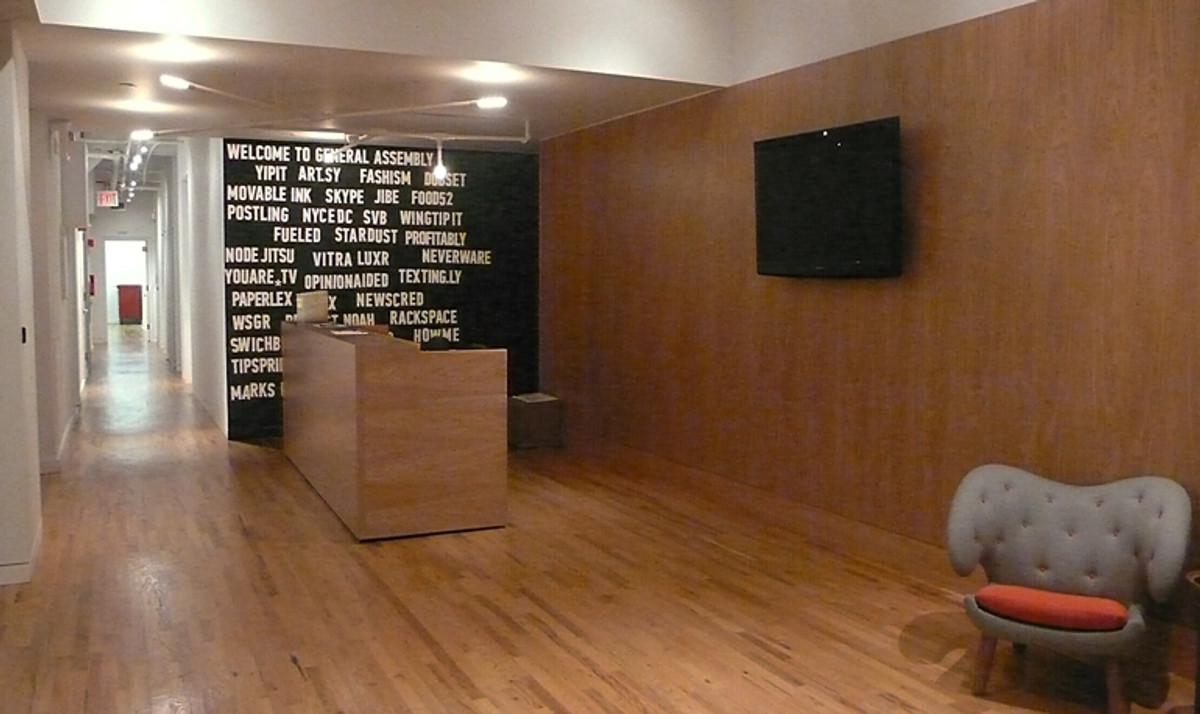 Where do technology and design intersect? Increasing numbers of people say on Broadway between 20th and 21st Streets.
Where do technology and design intersect? Increasing numbers of people say on Broadway between 20th and 21st Streets.
I first read about General Assembly in a column buried on an inside page of the New York Times' real estate section. It was presented as a place for technology and design entrepreneurs to rent desk space and get access to a library, conference and classroom spaces, lounge, and kitchen with free-trade coffee.
Over the past six months, GA -- developed by recent Ivy League graduates Adam Pritzker, Matthew Brimer, Brad Hargreaves and Jake Schwartz -- has established itself as more than a superior alternative to plugging in at a Starbucks. It's become an in-demand meeting place, learning center and business incubator.
GA's 16,000-square-foot space on the fourth floor of a Flatiron district office building is a cross between the coolest shared office space ever, a membership club, and a college campus, the metaphor preferred by the founders. Indeed, the "campus map," above, which is a giant mural on the wall opposite the elevators, lists its key activities including concepting, convening, coworking, decision making, designing, fireside chatting, hackathoning, pitching, reading and relaxing, serendipitous conversing, shaping best practices, whiteboarding and workshopping.
"The space was designed to inspire the next generation of entrepreneurs," says Mimi O. Chun, General Assembly's design director, an AIGA/NY board member who formerly was lead designer in IDEO's NY office "We think of ourselves as a community of people who are passionate about technology and design. There are opportunities for shared learning, discussions, events and classes, most in the evening so you can keep your day job and augment your education without committing to a full- or part-time graduate program."
"There are many different ways to engage here," Chun adds. "We believe that a multidisciplinary approach often yields the best outcomes, so we offer classes that help non-designers understand how design can impact their products, as well as classes that help designers increase their understanding of technology and entrepreneurship."
There are several different membership levels. Sixteen start-up teams that were selected though an application process are currently based in two dedicated work areas; the companies include a personalized daily deal site, a crowdsourced fashion site, and a kind of Pandora for the fine arts, a high-end marketplace where you're offered personal recommendations based on tastes and preferences. Developers of other start-ups work in the big communal space, which offers comfy sofas, a long beverage-snack bar, and an even longer table where people can either tune into their own electronics or collaborate and interact. There's a long waiting list for the options mentioned in the Times column: $600 a month desk spaces and $300 a month 24-hour access membership, which includes discounts on classes.
Three or four classes -- open to members and the public on an à la carte basis -- are held every night; you can subscribe and get a weekly e-mail with listings. Class subjects range from fundraising and legal issues for start-ups to more esoteric topics like "Introduction to iOS Development," that is, writing code for Apple devices, and "Feedback Loops," which is about using social incentives to acquire and engage players of online games. 
On the past two Thursday evenings I was at the table in the "Breaking Creative Barriers in Design" workshop taught by 2006 Pratt interactive media graduate Adrian Cabrero, at head of table above. My fellow students included an architect who's developing a shopping site for small-town businesses; the founder of a website design and analysis consultancy; a young woman who's fine-tuning an online store for handmade jewelry; and the developer of an ambitious online tool to help high school teachers and students keep track of their schedules and assignments.
The class gave each of us the opportunity to have our ideas critiqued by a cohort of peers. I brought to the table (and whiteboard, actually the whole wall) a brand identity I'm working on for Tourbie, a site that offers personalized travel experiences. Not surprisingly, I got pushed out of my "too corporate" comfort zone into friendlier territory inhabited by dogs, bunnies, and magic carpets. And I realized that in my career I'd always been either an employee or a boss, neither of which truly afforded the opportunity for the kind of deep, honest interaction with knowledgeable and trustworthy peers I got at GA.
To make its programming accessible to a broad audience, GA offers free events that require only an RSVP, including a "Reinvent NYC Hackathon" coming up this weekend. If you sign up, you'll get to spend two days with teams of local developers designing and launching your vision for the official New York City government site.
Copyright F+W Media Inc. 2011.
Salon is proud to feature content from Imprint, the fastest-growing design community on the web. Brought to you by Print magazine, America's oldest and most trusted design voice, Imprint features some of the biggest names in the industry covering visual culture from every angle. Imprint advances and expands the design conversation, providing fresh daily content to the community (and now to salon.com!), sparking conversation, competition, criticism, and passion among its members.







Shares